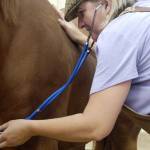Shivers in Horses

Shivers is a fairly uncommon equine condition characterized by tremors and exaggerated flexion of the hind limbs that is most noticeable when the horse is backed or its hind limbs are picked up (for example, for farriery). Often, the horse will also raise its tail head during an episode. The forelimbs are not usually affected, but if they are, the horse will hold its fore leg extended with the hoof just off the ground. Affected horses usually also have muscle loss and weakness.
Shivers is most common in draft breeds, but has also been observed in Quarter Horses, Warmbloods, and rarely in Thoroughbreds. Although it is unproven, shivers is believed to be an inherited trait in draft horses. There is no known effective treatment for shivers and the prognosis for affected horses is guarded because many continue to worsen and may eventually require euthanasia.
The exact cause of shivers remains unknown. Some researchers have speculated that shivers is caused by an abnormal response in the nerves that sense position and tension in muscles and joints. When microscopically examining muscle from horses with shivers, researchers have seen muscle abnormalities similar to those observed with polysaccharide storage myopathy (PSSM). A study of 103 Belgian draft horses at least one year of age found shivers in 18% of the horses examined. Researchers took muscle biopsies from all 103 horses and observed the lesions of PSSM in 36% of horses. Only 6% of horses had both PSSM and shivers. Serum concentrations of selenium and vitamin E were not significantly different between normal horses and horses with shivers or PSSM. There was no statistically significant association between a horse having both PSSM and shivers.
Several researchers have stated that since microscopic changes consistent with PSSM are so common in draft breeds (up to 66% of horses in some studies), that it is difficult to definitively link shivers with PSSM. However, it is possible that some clinical signs of PSSM, such as gait abnormalities, could be interpreted as the horse having shivers.
Muscle biopsy is a useful diagnostic test for horses with shivers to rule out PSSM. If PSSM is present, then dietary change to a higher fat, lower carbohydrate diet may help improve clinical signs in some horses.
There are a number of anecdotal reports of clinical improvement in shivers cases when horses are given large doses (5,000 IU) of natural vitamin E in the form of Nano•E. It is recommended that blood vitamin E levels be monitored to check that the dose is high enough or has been given long enough to significantly raise blood levels of vitamin E.








